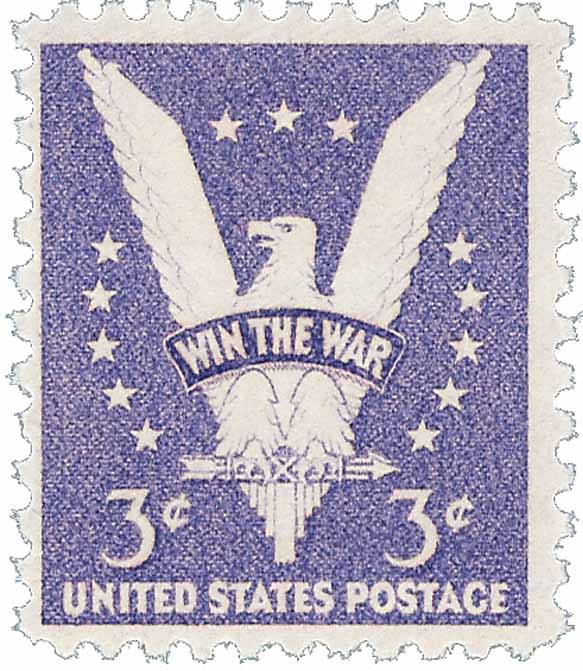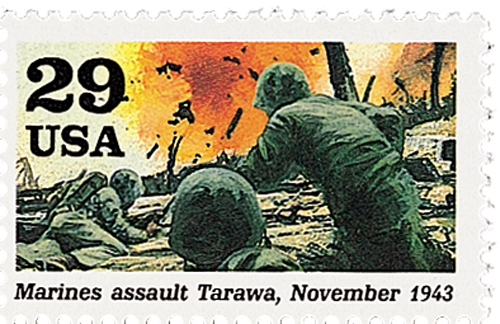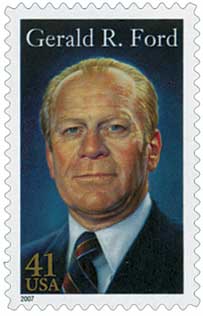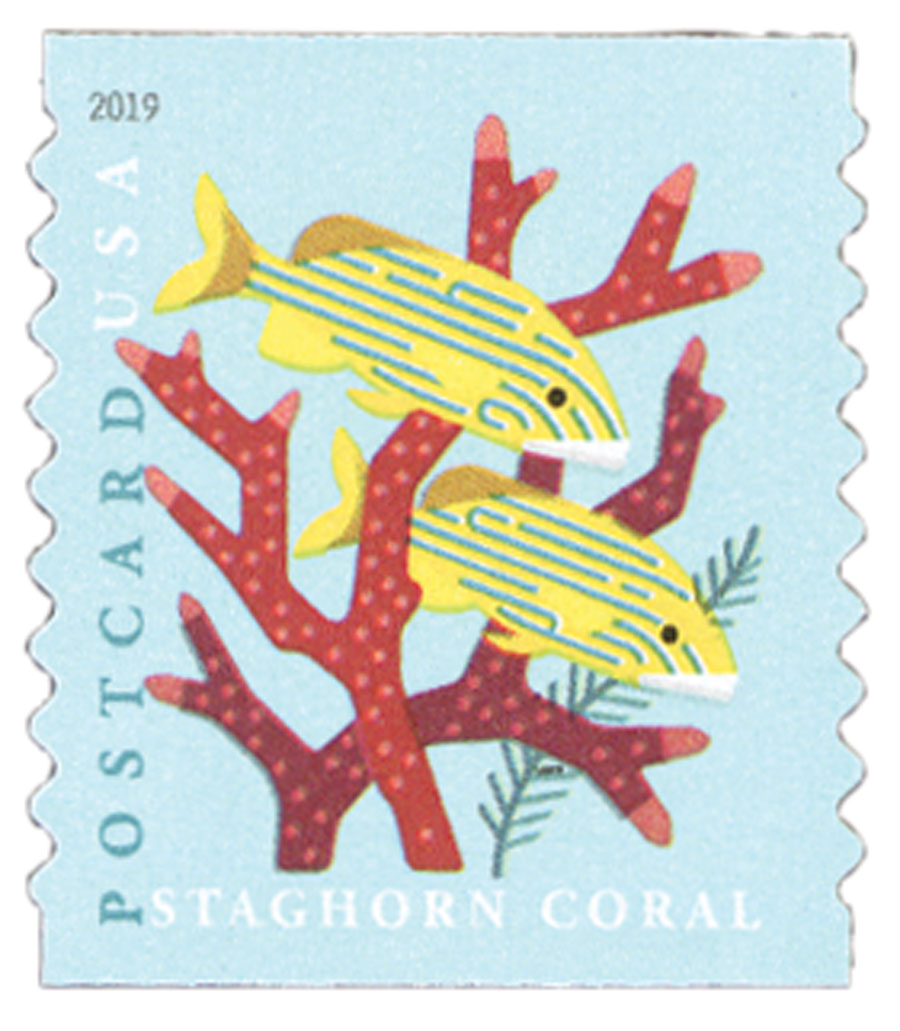
# 5368 - 2019 35c Coral Reefs: Staghorn Coral (coil)
U.S. #5368
2019 35¢ Coral Reefs – Staghorn Coral
Staghorn coral are fast growers, making them some of the world's greatest reef builders. Many scientists credit the staghorn as one of the leading coral that built up the Caribbean coral reefs over the last 5,000 years.
The average staghorn coral can grow up to eight inches in branch length per year – reaching sizes of eight feet in diameter and four feet in height. Their lighter skeletons allow them to grow at this rate. Staghorn coral use this to their advantage so that they can receive more space and sunlight compared to neighboring coral on the reef.
There are nearly 400 species of staghorn coral. Some have the distinctive antler-like shape that give them their name. There are also species of staghorn coral that form into delicate plates up to 10 feet across. Some also form bush-shaped structures with finger-like branches. Regardless of the different species, staghorn coral will grow together in colonies. They form dense groups known as "thickets" that provide an essential habitat for marine life, including a variety of fish.
Staghorn coral were once abundant, but disease and climate change have taken a toll. The coral are now considered critically endangered. However, scientists are optimistic that the staghorn coral's ability to grow quickly will help it to recover its numbers over time.
Battle of Kwajalein

The Battle of Kwajalein began on January 31, 1944. Part of the World War II Pacific Campaign, it was a hard-fought, but quick victory for the US, allowing commanders to launch the next battles sooner than expected.
Following World War I, Japan was granted control of the Marshall Islands in the western Pacific. The Allies knew going into World War II that these islands would be an important strategic target.

After the Japanese had several successive victories in the early months of the war, US Admiral Chester Nimitz developed an “island-hopping” strategy. This counteroffensive consisted of a series of landings on certain Japanese-held islands along the way to the Philippines and eventually Japan. Kwajalein was the target in early 1944. In the heart of the Marshall Islands, Kwajalein Atoll is the world’s largest coral atoll, spreading across 93 islands and islets, totaling 1,560 acres. The key points in the atoll were Kwajalein Island in the south and the connected islands of Roi-Namur in the north.

After two months of air and naval bombardments in the area, US Marine and Army units landed on Kwajalein, Roi, and Namur on January 31, 1944. A total of 85,000 US Marines and Army men aboard 300 warships participated in the assault. One Marine regiment captured Roi on the first day and Namur was taken by noon on the second day. The battle on Kwajalein was more difficult, with the US 7th Infantry Division bombarding the Japanese garrison for three days before it was declared secure on February 4.

The Japanese forces were outnumbered by more than 40,000 on Kwajalein, but fought to the bitter end. They suffered 7,870 dead and 105 captured in the battles on Roi and Namur, while the Marines lost 200 of their own with 500 wounded. On Kwajalein, 5,000 Japanese were killed, and a small number captured. The Americans on Kwajalein saw 372 killed and 1,592 wounded.

The capture of Kwajalein was completed much earlier than Admiral Nimitz had expected. This in turn allowed him to move up his planned attack on Eniwetok by 60 days. The continued success of this island-hopping campaign meant further isolation of those islands that had been skipped, making for easier victories there as well.
U.S. #5368
2019 35¢ Coral Reefs – Staghorn Coral
Staghorn coral are fast growers, making them some of the world's greatest reef builders. Many scientists credit the staghorn as one of the leading coral that built up the Caribbean coral reefs over the last 5,000 years.
The average staghorn coral can grow up to eight inches in branch length per year – reaching sizes of eight feet in diameter and four feet in height. Their lighter skeletons allow them to grow at this rate. Staghorn coral use this to their advantage so that they can receive more space and sunlight compared to neighboring coral on the reef.
There are nearly 400 species of staghorn coral. Some have the distinctive antler-like shape that give them their name. There are also species of staghorn coral that form into delicate plates up to 10 feet across. Some also form bush-shaped structures with finger-like branches. Regardless of the different species, staghorn coral will grow together in colonies. They form dense groups known as "thickets" that provide an essential habitat for marine life, including a variety of fish.
Staghorn coral were once abundant, but disease and climate change have taken a toll. The coral are now considered critically endangered. However, scientists are optimistic that the staghorn coral's ability to grow quickly will help it to recover its numbers over time.
Battle of Kwajalein

The Battle of Kwajalein began on January 31, 1944. Part of the World War II Pacific Campaign, it was a hard-fought, but quick victory for the US, allowing commanders to launch the next battles sooner than expected.
Following World War I, Japan was granted control of the Marshall Islands in the western Pacific. The Allies knew going into World War II that these islands would be an important strategic target.

After the Japanese had several successive victories in the early months of the war, US Admiral Chester Nimitz developed an “island-hopping” strategy. This counteroffensive consisted of a series of landings on certain Japanese-held islands along the way to the Philippines and eventually Japan. Kwajalein was the target in early 1944. In the heart of the Marshall Islands, Kwajalein Atoll is the world’s largest coral atoll, spreading across 93 islands and islets, totaling 1,560 acres. The key points in the atoll were Kwajalein Island in the south and the connected islands of Roi-Namur in the north.

After two months of air and naval bombardments in the area, US Marine and Army units landed on Kwajalein, Roi, and Namur on January 31, 1944. A total of 85,000 US Marines and Army men aboard 300 warships participated in the assault. One Marine regiment captured Roi on the first day and Namur was taken by noon on the second day. The battle on Kwajalein was more difficult, with the US 7th Infantry Division bombarding the Japanese garrison for three days before it was declared secure on February 4.

The Japanese forces were outnumbered by more than 40,000 on Kwajalein, but fought to the bitter end. They suffered 7,870 dead and 105 captured in the battles on Roi and Namur, while the Marines lost 200 of their own with 500 wounded. On Kwajalein, 5,000 Japanese were killed, and a small number captured. The Americans on Kwajalein saw 372 killed and 1,592 wounded.

The capture of Kwajalein was completed much earlier than Admiral Nimitz had expected. This in turn allowed him to move up his planned attack on Eniwetok by 60 days. The continued success of this island-hopping campaign meant further isolation of those islands that had been skipped, making for easier victories there as well.








